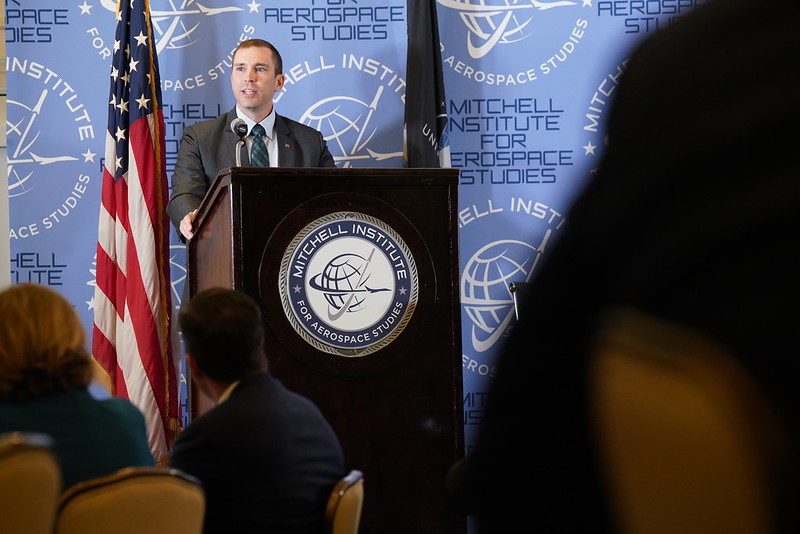As the Space Development Agency celebrates the successful first launch of its planned constellation of low-Earth orbit satellites, director Derek M. Tournear says he’s no longer concerned about China or Russia trying to shoot U.S. satellites down.
“I’m not worried about any physical threats to the satellites themselves. I’m just not,” Tournear said April 5 at the Mitchell Institute’s Spacepower Security Forum.
By deploying hundreds of satellites in SDA’s new Proliferated Warfighter Space Architecture, the Space Force is recalculating the economics of space warfare. SDA’s initial batch of PWSA satellites, dubbed Tranche 0, will number just 28. But close on its heals will be Tranche 1 with more than 150 satellites and Tranche 2 with more than 250. Tranche 1 launches are set to begin in the fall of 2024, and Tranche 2 will follow in 2026.
“We’ll have hundreds and hundreds of these satellites up there,” Tournear said. “It will cost more to shoot down a single satellite than it will cost to build that single satellite. We just completely changed that value equation.”
Replacing a space architecture built of massively expensive bespoke satellites with one assembled from numerous relatively cheap satellites, SDA and Tournear aim to convince adversaries that the math is no longer in their favor, rendering essentially useless China’s and Russia’s direct-ascent weapons. In theory, at least, such strikes effectively become as great a threat to the perpetrator’s satellites because of the debris that they would generate as to the U.S. satellites they might seek to shoot down.
Cost
For the U.S. strategy to work, SDA must hold down satellite and launch costs while driving increased performance. Tournear said SDA aims for a per-satellite cost under $15 million.
“I’m counting on internal investments in industry to help push this forward,” Tournear said. “My goal is just like the cell phone model—we will keep the price of the satellites to the government essentially flat. Just like your cell phone has a certain fixed price … But the capabilities will continue to advance. So for that same price, every tranche will give you more and more capabilities for the same price. That’s kind of the model, just like the cell phone. Basically, the price is flat, but each new model has more and more capabilities.”
Numbers
The value equation also depends on SDA continuing to put hundreds of active satellites into orbit. Its first Tranche 0 launch this past weekend is a start, but Tournear aims to develop subsequent generations in parallel, similar to the way commercial technology products are developed. He’s already looking to Tranche 1 and Tranche 2, even before he completes Traunche 0.
Tranche 1 contracts for 126 data transport satellites and 35 missile tracking satellites are already signed, as are orders for 12 satellites in the Tranche 1 Demonstration and Experimentation System. Tournear confirmed that Tranche 1 launches are slated to start in September 2024, with monthly launches to follow.
Expanding on initial projections that Tranche 2 would consist of a 250-satellite Transport Layer and a 50-satellite Tracking Layer, Tournear said April 5 that the Tranche 2 data transport layer will be split three ways:
- 100 Alpha satellites, similar to those in the Tranche 1 Transport Layer
- 72 Beta satellites with ultra-high-frequency and tactical communications payloads
- 44 Gamma satellites, carrying “advanced waveform” payloads
SDA will issue a request for proposals for the Beta satellites “next week,” Tournear said, with RFPs for the Alpha and Gamma satellites to follow in late 2023 or early 2024.
Tournear was thin on details about the Tranche 2 Tracking Layer, saying requirements are still being developed by SDA’s Warfighter Council. But he suggested it will encompass “on the order of 54” satellites and said an industry solicitation is likely in between the Alpha and Gamma RFPs.
Threats
Looking ahead, Tournear said he is confident SDA’s plan will deter physical attacks on U.S. satellites, but he remains concerned by “common mode failures”—problems or threats that could affect the entire constellation.
“You can’t proliferate your way out of common mode failures,” he said.
The two threats in particular: cybersecurity and breaches of the supply chain.
Defense officials have increasingly voiced concerns about cyber vulnerabilities in space, including by means of ground stations which had not previously been seen as lucrative targets. But Tournear said SDA is now taking steps to ensure those architectures are also secure.
“That’s why we have a lot of protections and constraints in place on our contracts that aren’t typical on what you would call a commercial, commoditized procurement,” Tournear said. “We put some requirements in it.”
Satellite supply chains are also of concern. Supply chains in general garnered far greater attention as a result of weaknesses exposed by the COVID-19 pandemic, but also because breaches at the chip or component level are so difficult to, making the supply chain vulnerable to the likes of China.
Tournear said both problems concern him. “One is just your benign supply chain problems—can we really build these satellites this quickly?” Tournear said. “And we’re building up industry, so yes, we can, so we’re kind of keeping down that supply chain risk. The second one is more the nefarious supply chain [issue], and that’s the actual interdiction by a nefarious actor into a supply chain,” he continued. “We actually put a lot of protections in place in our contracts so that we can evaluate and make sure that we have nondestructive testing in place to detect that.”
